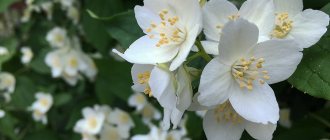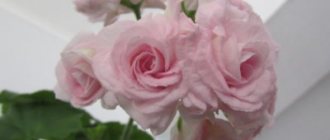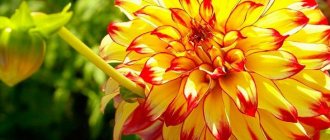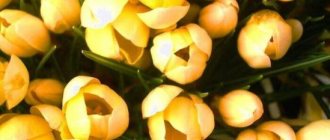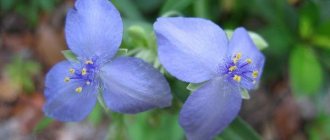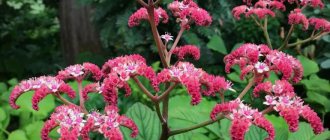Author: Elena N. https://floristics.info/ru/index.php?option=com_contact&view=contact&id=19 Category: Houseplants Published: October 26, 2011Republished: February 25, 2019Last edits: March 11, 2021
- Jasmine beesianum / Jasminum beesianum
Description
It is a climbing or erect, evergreen shrub of the olive family. The leaves are uniformly green in color, trifoliate or odd-pinnate in shape.
Flowers with a large corolla of regular outline, white, pale yellow or pink, with a pronounced sweet aroma. Flowering ends with the formation of an inedible berry.
The habitat today is represented by almost all the warm edges of the planet - from Africa and Australia to central America and southern Europe.
Some types of jasmine also grow in Russia, the northern Caucasus, Crimea, Kuban, Altai, and Southern Urals. Artificial cultivation is widely practiced in China.
A little history about jasmine
Many ignorant people confuse mock orange, which grows everywhere in central Eurasia, with real jasmine. It is precisely on this basis that when talking about jasmine, they constantly clarify what kind they are talking about, real or fake.
The correct place of origin of this representative of the flora has not yet been fully recognized. While the olive branch, which is a striking representative of the family, is mentioned in ancient scrolls and depicted on amphoras and vases discovered on the island of Crete dating back to the 2nd millennium BC, there is no such evidence about jasmine. But it is conventionally accepted to consider China as the homeland of jasmine. But such a statement remains controversial.
Since jasmine is still the national flower of Pakistan, the Philippines and India.
Translated from Persian, the word yasmin is translated as a fragrant flower. Indeed, the smell of jasmine cannot be confused with another smell.
The enchanting smell of this plant has been known all over the world since ancient times. There are references to the use of this plant for flavoring and decoration in the palaces of various states of distant times. To this day, garlands and wreaths are woven from jasmine flowers for honored guests, for weddings in various Asian countries, in Indonesia and the Pacific Islands.
Jasmine is sacred to the Tatars.
In Latin America, Italy and India, flowers and shoots of plants are serious religious attributes. Until now, jasmine oil, which is used in pharmaceuticals and perfumery, is the most valuable essential oil in the world (there are about 7 million flowers per 1 kilogram, the price is almost $6,000).
Varieties
More than 250 varieties of this plant are known, which appeared through natural processes or created by breeders. The most famous and widespread.
Turned away. It is distinguished by bright yellow inflorescences and a strong aroma throughout the entire flowering period. Honey plant actively attracts bees and other insects. The leaves are paired, bright green.
Sambac. A liana-like variety that can grow up to 6-8 meters in length. Large leaves, and neat white inflorescences are collected in fragrant bouquets. The woody stems give a special aesthetics; landscape designers and those who like to decorate their garden plot with hedges liked all this.
Flattened. A shrub that, if properly pruned, pleases with a large number of flowers in soft pink shades and an equally refined scent that exudes all summer.
Bisa. One of the most popular decorative varieties. The vines reach a length of 2-3 meters and are strewn with umbrellas of large bright pink inflorescences with a bluish tint. If desired, you can also give it a bushy form. Combined with large, dark green leaves to create a wonderful tool for forming a living wall.
Drug. The most popular among window sill pharmacy lovers. Despite its main purpose, it has good decorative qualities. Smooth branches covered with oblong leaves and white racemose inflorescences look quite nice, and they will delight you with flowering for a long time - from April to autumn.
The thinnest. It is distinguished by “falling” shoots and large white inflorescences. The aroma, although not as pronounced as that of the above-described species, has pleasant specific notes. The leaves are dirty green, slightly pubescent at the base.
Multi-flowered. A very large, lush shrub up to two meters high, during the flowering period it is covered with an abundant “carpet” of pink and white flowers. It has the most powerful aroma of all known varieties. In addition, it is easy to recognize by its unusually shaped leaves, reminiscent of a wavy dagger.
Large-flowered. As can be understood from the name, it is distinguished by large white flowers, collected in umbrellas of 7-10 pieces. The shoots themselves can be up to ten meters long, which provides wide decorative possibilities, but imposes some pruning responsibilities.
Landing
It is important to remember that plants that are planted in early spring take root much better and faster. But planting jasmine bushes can be done both in spring and autumn.
What do I need to do?
- Dig a hole with a depth and diameter of approximately 60 cm.
- Place a drainage layer at the bottom of the hole, and sprinkle a little nitrophoska and soil mixture on top of it.
- Evenly and carefully distribute the jasmine roots in the hole and cover with fertile soil. To prevent rotting of the bush, you do not need to deepen its base by more than 2-3 cm.
- Compact the soil at the base of the bush.
- Water the jasmine generously with water in a volume of about 15-20 liters.
- Apply mulch around the tree trunk area to reduce moisture evaporation.
Growing
When planting jasmine in our difficult latitudes, you need to take into account the following nuances:
- the plant is not particularly demanding on the mineral composition of the soil, but if you need an intoxicating aroma and abundant flowering, it must be fertile;
- plant either in early spring or late autumn - this is the best time for rooting;
- You should pay close attention to the behavior of groundwater and water circulation in the area as a whole, and plant only in places that are not subject to stagnant water, or neutralize them using crushed stone cushions.
The hole for planting jasmine should be about half a meter deep, and you need to add a little nitrogen-phosphorus fertilizer to it. After planting and compacting, it is necessary to water abundantly.
How to care
In order to fully enjoy the beauty of mock orange, you need to follow the basic rules of planting and caring for the plant.
Soil selection
The best soil in this case is a mixture containing 3 parts leaf soil, 1 part sand and 2 parts humus. Particular attention should be paid to ensuring that the soil is breathable, loose and fertile. It is necessary to maintain a neutral acidity level.
Location and lighting
For abundant flowering, mock orange requires sun, so it is better to choose a sunny place for planting. Even prolonged exposure to direct sunlight will not harm it. The plant will not like swampy and shady areas.
Temperature, humidity and watering
Watering directly depends on the quality of the soil. The plant especially needs moisture in the spring, before the flowering period, but most often at this time the soil receives moisture naturally. In case of a dry spring, moderate watering will be necessary. Mock orange should not be allowed to grow in constantly wet soil. It does not grow well in places where groundwater flows or in places where there is a constant supply of moisture. An adult plant tolerates Russian frosts and temperatures of +30...+40 degrees in the summer.
Fertilizers and fertilizers
To a greater extent, mock orange needs feeding during the period of its active growth, that is, in early spring, when it best absorbs nutrients. In the first year and only once, preferably towards the end of spring, 1 bucket of infusion consisting of water and slurry in a ratio of 10:1 must be added under the jasmine bush. In subsequent years, garden jasmine is fed exclusively with mineral fertilizers containing urea, potassium sulfate and superphosphate. Ash from an old fire is a good fertilizer for jasmine.
Transfer
Due to the fact that the root system of garden jasmine is quite compact, the replanting process is safe for the plant. The most optimal period for transplantation is considered to be early autumn or spring. You need to start by preparing a hole for the bush, the size of which depends solely on the volume of the root. The most suitable hole dimensions are 60x60x60. In order to preserve the earthen lump on the roots, the plant is subjected to abundant watering on the eve of transplantation. The side shoots must be removed, the central 3 stems must be cut to a height of thirty to forty centimeters.
In case of spring transplantation, the plant needs feeding. When the plant takes root, fresh ones appear on the “stumps” remaining after removing the side shoots. After wintering, the strongest of the fresh shoots are left, and the rest are removed. With this technology, mock orange will bloom in the 3-4th year. A large shrub can be divided in case of transplantation.
Trimming
To create a lush and fragrant jasmine bush, in addition to regular care and systematic watering, the plant should be pruned. Moreover, this should be done correctly and systematically.
Rules for pruning mock orange:
- Pruning is best done while the plant is in a vegetative state, that is, in the spring.
- Those branches that are significantly longer than the rest need to be cut off at the root. Branches of medium length - half.
- Using special scissors, it is necessary to remove all branches on which flowering does not occur. In this way, the so-called “anti-aging pruning” is carried out.
- The central trunk of an adult bush needs to be shortened by 40-60 centimeters.
Winter care
An adult garden jasmine does not need special care in winter; it does not need to be covered. Young specimens should be covered for the winter with a layer of peat or pine needles. It is useful to cover the place where the root system is located with leaf humus. After heavy snowfalls and at the end of winter, it is necessary to free the crown of the bush from the snow cap.
Features at home
If you plan to use jasmine as an indoor flower, then it should be placed in spacious rooms. A powerful aroma is wonderful in an open garden, but in a confined space its abundance can have a detrimental effect on well-being.
The plant itself can suffer from the wrong location and tap water. Sun rays refracted through double-glazed windows can burn delicate foliage, causing it to yellow and die.
Butterflies: beautiful creatures from the world of insects- How to grow excellent petunia seedlings
- How to properly water an orchid in a pot: the benefits of automatic watering for the plant
The same goes for hard tap water. To avoid these troubles, you need to use a softening filter and choose a place without excessive sunlight.
If these conditions are met, but your bush still does not want to bloom, most likely there were errors during planting in the form of too deep grounding. The solution is to replant so that the rhizome sticks out of the ground a little. The cause may also be insufficient soil acidity, which can be solved with appropriate fertilizers.
Reproduction methods
It is very easy to propagate garden jasmine. So, there are several ways:
- Seeds. Seeds are sown both in open ground and in a box at home (growing through seedlings).
- Cuttings. It is recommended to cut cuttings in the first days of June. They are then planted either in open soil or in a greenhouse.
- Escape. In spring, shoots should be prepared by separating them from the mother plant. The choice should be made on the strongest shoots. After they overwinter, with the onset of spring they are transplanted to a permanent place.
- Dividing the root system. This is not the most popular method of reproduction. It is recommended to divide in the autumn.
Unpretentious plants for the garden How to propagate mock orange or garden jasmine
You should also be sure to remember that indoor and garden jasmine are different crops, and each of them requires special care.
Application
Who hasn’t drunk green tea with jasmine flowers, the properties of which give the drink a unique range of smells? This combination is so loved by consumers that today it can be found in any store. It is also used as a flavoring agent for confectionery products, alcoholic beverages and other food products.
It is curious that photos of jasmine flowers on tea boxes are sometimes images of mock orange. These plants are often confused due to their similar aroma and appearance.
In addition to its decorative and gastronomic value, some of the properties of this universal plant have found application in folk medicine and medical cosmetology.
General information
Jasmine is considered a symbol of love, passion and deep affection. Jasmine is the commonly known name for plants of the jasmine genus. It belongs to the Olive family.
If the rules of care are followed, the lower part of the stem is slowly covered with wood, and jasmine is often used by gardeners as a decorative element in garden design. The shrub blooms every year and does not require much care. It is often confused with another plant - mock orange, which belongs to the Hydrangeaceae family.
Many gardeners love jasmine for its abundant flowering and unpretentiousness. Its aroma is delicate and very pleasant, but when grown at home, the smell can become quite concentrated, which can lead to severe headaches.
Below is more detailed information about planting, caring for and propagating jasmine shrubs.
Healing properties
The benefits of jasmine flowers are due to the high content of many essential acids and essential oils. Leaves and flowers, due to the presence of salicyl-containing elements in them, have mild antiseptic properties sufficient to disinfect cuts.
Essential oils and flower decoctions are widely used as a tonic that has a beneficial effect on all organ systems, especially the nervous one.
There is also a positive effect on the female body during lactation and menstruation. Medicines for insomnia and migraines are prepared from the roots.
People with hypertension and stomach ulcers, as well as allergy sufferers, should be careful when using jasmine.
Flower diseases and pests
Indoor jasmine may be attacked by:
- aphids;
- tick;
- leaf weevil.
These insects feed on plant sap. As a result, the bush becomes sick, stops flowering, drops its leaves and may die if the cause of the wilting is not detected in a timely manner and is not eliminated. To prevent death, the flower is systematically examined.
Aphids are easy to spot: they nest on the upper shoots. Mites are identified by webs on the underside of the leaf. The weevil lives in the soil, and the plant sap is consumed by the larvae. Pest control involves the use of special insecticides in accordance with the instructions attached to them.
Interesting Facts
- Jasmine produces its strongest aroma at night, which is due to the plant blooming at its maximum when temperatures drop at the end of the day.
- Jasmine is an essential flower for wedding ceremonies in Indonesia.
- In Asia, a potion is made from jasmine flowers, sugar and alcohol, which is believed to relieve cowardice. At the same time, a person becomes invulnerable to the bites of poisonous scorpions and snakes.
- Under natural growing conditions, jasmine lives up to 20 years.
Care
The jasmine bush (photo presented in the article) is very unpretentious in care. However, its greatest decorativeness and attractiveness can be achieved by performing the following activities:
- periodic loosening of the soil around the bush trunk;
- application of fertilizers (organic, phosphate-containing and mineral) for abundant flowering and increased immunity;
- periodically pinching branches to give the crown a beautiful, regular shape;
- removing old inflorescences and weeding;
- adding mulch;
- timely soil moisture.
Trimming steps
In order for the jasmine bush to delight you every year with its fragrant, magnificent flowering and beautiful decorative forms, it is necessary to prune the bush correctly:
- In spring, approximately 5 branches should be cut off at a height of 40-50 centimeters from the soil surface, and the remaining stems should be removed to the very base of the bush.
- Fresh cuts must be treated with garden varnish to protect and quickly heal the bush.
- Shoots growing from dormant buds should be removed, leaving a few of the strongest branches on the old stems. All of them will become the basis of the updated bush.
The plant will acquire its proper appearance in a year, and after three years it will bloom profusely.
